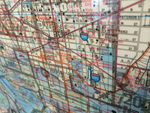Not so long ago, Ketchikan was a rugged and exotic intersection of cultures built on the profits of logging Southeast's rainforest, but in 15 years, it has transformed itself into a tourist center, softening its rough edges while selling their charm to visitors. Southeast Alaska's last major timber mill -- the Louisiana Pacific pulp plant in Ward Cove, north of town -- closed in 1997 due in part to environmental concerns.
On summer days, the white cruise ships tower above the town like huge new buildings on the dock facing Front Street, the downtown's main drag. Each morning their gangways disgorge thousands of visitors, clogging the streets and for a few hours transforming the town into a teeming carnival. On their short visits, the passengers explore the closest of the twisting streets, see the museum at the Southeast Alaska Discovery Center, or take a tour to one of the totem pole parks. Then evening comes, the streets empty, and the cruise ships slide off quietly on the way to their next port.
Then a sense of the old, misty, mysterious Ketchikan starts to return. Visitors with a little more time to spend, and the willingness to explore beyond the core tourist areas, can drink in the history and atmosphere of the place. Stay in a quaint old hotel, enjoy some fresh fish, hike a boardwalk path through the primeval rainforest, and visit the museums, clan house replicas, and totem pole parks that make Ketchikan a center of Tlingit and Haida culture.
Ketchikan also makes a great jumping-off point for some spectacular outdoor experiences, including a trip to Misty Fjords National Monument. As the state's fourth-largest city, Ketchikan is the transportation hub for the southern portion of Southeast Alaska. (The nicknames "Gateway City" and "First City" refer to its geographical location and transportation function.) Seaplanes based on docks along the waterfront are the taxis of the region, and a big interagency visitor center can get you started on your explorations of the area. Ketchikan is one of the wettest spots on Earth, with rain measured in the hundreds of inches; quality rain gear is requisite for any activity, in the wilds or in the streets of town.








